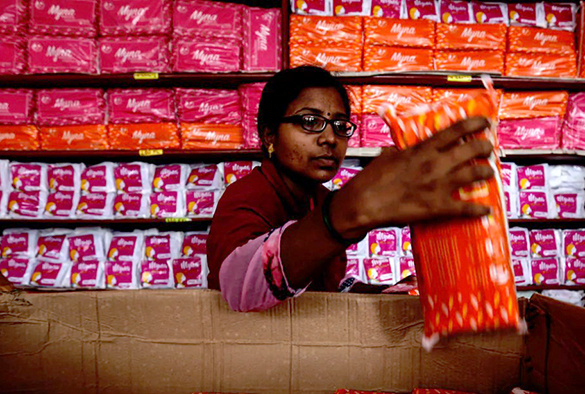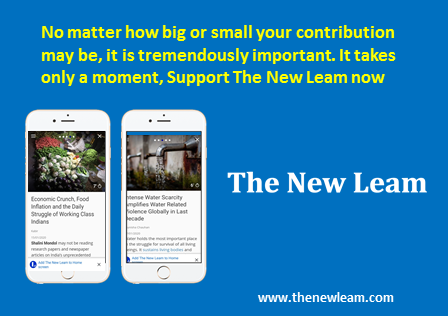The coronavirus pandemic and its economic and social fallouts are being discussed time and again in the public domain and issues such as the migrant crisis in India, the severe loss of livelihood opportunities and the crumbling of the informal economy and the overburdening of the medical infrastructure have been regular points for discussion.
But an aspect that we tend to overlook or pay little attention to, is regarding the fact that the coronavirus pandemic has been nothing short of a “sanitary pad crisis” in India affecting the lives of millions of ordinary women.
When we talk about such a crisis, it is important to note that in most corners of India, the usage of sanitary pads continues to be seen as a luxury and not a necessity. Therefore expenditure on sanitary pads is among the firsts to cut out from a family’s budget during the times of financial crunch and this is what has happened amid the pandemic.
Loss of employment has left India’s poor and vulnerable sections struggling to make the two ends meet and amid all this, many girls and women have been compelled to give up on the usage of sanitary pads and resort to traditional and often unsafe alternatives that are life threatening.
In some parts of India, schools are a critical part of the supply chain, providing a pack of pads to menstruating girls each month. Along with access to food, the closure of schools has meant that now fewer girls have access to pads. Only 15% Indian girls had access to sanitary pads amid the nationwide lockdown.
This is not an isolated event limited to India, even in countries like Fiji,US, UK and several other corners of the world, a severe shortage of supplies of sanitary pads have been reported and the price of sanitary products has multiplied several times.
But there can be no doubt about the fact that in India the shortage of pads has been particularly acute and the situation has fast escalated into becoming very grave.
As India went into a sudden lockdown on March 24, it put an immediate stop to the monthly supply of pads that millions of adolescent girls would receive through their schools. The production of sanitary pads was also severely affected in the initial days of the lockdown and this resulted in severe shortage in different corners of the country.
On March 30, pads were classified as part of essential items but the supplies haven’t become completely normal yet and in many places across the length and breadth of India, supply chains continue to be severely hit.
While many civil society organisations have been engaging with women at the grassroots level and teaching them how to make pads of their own and take care of their sanitary hygiene, there is no doubt that the increased prices and shortage of pads has indeed adversely affected many women in India.
In India, women are traditionally accustomed to using cloth to manage their periods but over the last couple of years there has been a constant emphasis to encourage them to make use of disposable pads as the only hygienic method of managing their periods.
But little has been done to make sure that awareness levels are enhanced on cheaper, more sustainable alternatives such as menstrual cups and reusable pads to manage periods.
Another commonly propagated myth in India is that managing periods properly only means having access to sanitary pads, there is little dissemination of information on the need for access to clean toilets with running water, equitable gender norms and privacy and dignity for women. The absence of these critical pointers apart from the shortage of sanitary pads has together made the crisis grave and period management quite unsustainable.
India’s Menstrual Health
It is important to note that India is home to more than 20% of the world’s menstruating girls and women and this also depicts the intensity of the crisis when access to sanitary health is a luxury rather than a fulfilled need. In a country where a large section of women continue to traditionally use cloth during their periods, it becomes a major challenge to ensure that they maintain their menstrual hygiene and dignity.
This is also the country where a great number of taboos on periods and sexual health fill the public discourse and thus it becomes a bigger challenge for the women who use non-disposable alternatives to take care of themselves.
While cloth may be considered an important solution, it does require the user to wash and dry it under the sun after every use. Although many women use cloth during their periods they feel ashamed to dry it in the open sunlight due to male presence or the fear of being humiliated by the society.
Women tend to dry the period cloth indoors, hide them under other pieces of clothing or dry them quite hurriedly to avoid public gaze. These practices tend to make the cloth unhygienic and substantiate the wrongly held assumption that cloth is inferior when compared to pads. In fact, the usage of pads doesn’t guarantee period hygiene because many women who used disposable pads used the same pad for the whole day or for two consecutive days if the flow was light.
Moreover, because of the general taboo around menstrual health, women in India feel ashamed to seek the help of more informed members of the community such as health workers, doctors or teachers.
This is quite difficult to achieve in a country where taboos about menstrual blood are prevalent.
It is for these reasons that several programs were launched by the government to freely distribute and sell pads at discounted prices.
This was seen as a tangible use of money paid to the government in the form of taxes.
Moreover, private companies that manufactured disposable pads contributed to creating better public awareness and an aspiration among women and girls to use pads. Many companies launched cheap pads in the competitive period market and the demand for sanitary pads rapidly rose to 48% in rural and 78% in urban areas in a period of just five years. According to the National Family Health Survey, pad users had multiplied four times in India and risen to 58%.
The Sustainable Disposable of Pads: A Major Ecological Threat
But while pads are being accessed by more women now, an important challenge is to make sure that pads are disposed ethically and in a manner that doesn’t harm the environment.
Many women in rural, semi-urban India dispose their used pads in water bodies such as rivers often unwrapped or at best wrapped in plastic. This is a major concern because such practices will poison and pollute water bodies and also because wet waste shifting is a domain of work which is done manually by sanitation workers in India.
They are often compelled to pick up wet and soiled, used and dirty pads from water bodies and landfills with their hands. In cities, used and soiled pads land up in huge landfills where they are segregated manually by sanitation workers.
Many schools, hospitals and government bodies have set up small-scale incinerators to destroy used pads at source but the emissions made by such incinerators is quite a big environmental concern.
To address this environmental concern, the government of Kerala distributed 5,000 free menstrual cups to women in the state in 2019. They did this as after the floods in 2018, women living in relief camps found it extremely difficult to dispose sanitary pads and menstrual cups eased their hardships to a great degree.
Although many efforts are being made in different corners of the country to address these challenges, without governmental policy-aid and funding, these efforts continue to remain small and sporadic.
Along with sustained government and civil society coordination, there is also a need to break the ice around menstrual health and hygiene and ensure that we arrive at a “period equity”, where every girl and woman in India has the ability to access, manage and spend her period with dignity and quality sanitary products that are ecologically viable and economically sustainable.
Ananya Pathak is the Features Editor / The New Leam.


